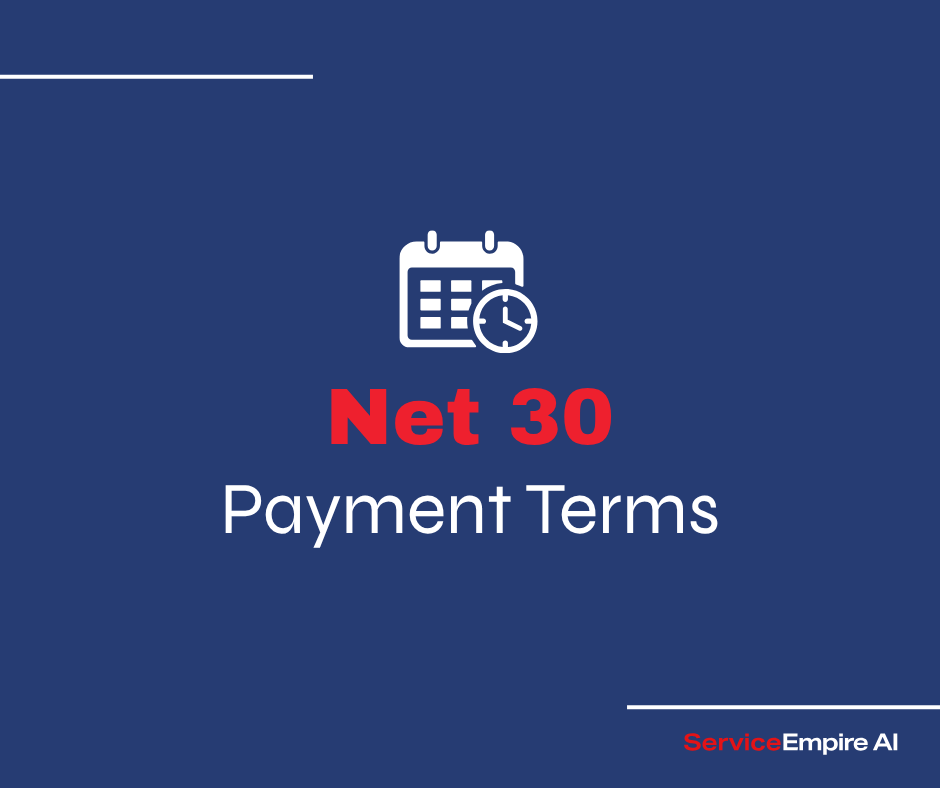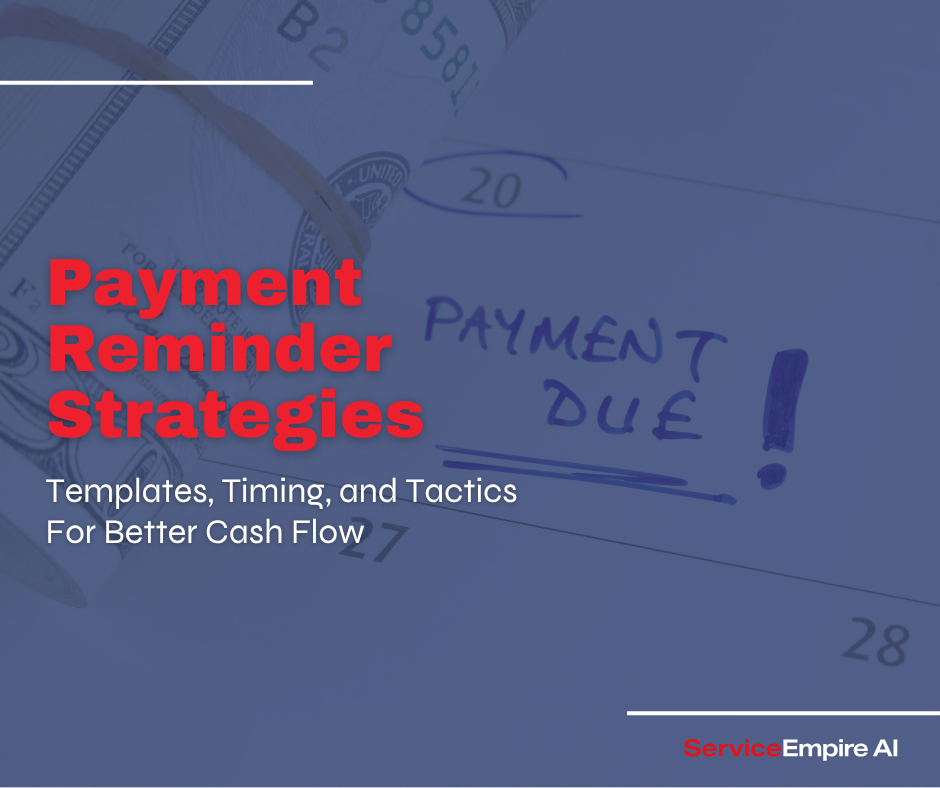
Introduction
Poor cash flow is the reason 82% of small businesses fail, according to a Score study. Learning how to manage cash flow is the lifeblood of your business. One key part of managing cash flow well is understanding payment terms, especially Net30.
Net30 means a customer has 30 days from the invoice date to pay in full. It’s one of the most common ways businesses handle payments.
Using Net30 correctly can help your business run smoothly, plan ahead, and stay financially healthy. Whether you’re setting payment terms, managing invoices, or working with vendors, knowing how Net30 works is an important part of doing business.
This simple guide covers what Net30 means, how to use it, and tips to make sure it helps your business—not hurts it.
What is Net30? The Basic Definition
Net30 is a standard payment term indicating that payment in full is due within 30 calendar days from the invoice date. The "net" refers to the total remaining amount due after any deductions such as discounts, credits, or returns have been applied. When an invoice states "Net30," it establishes a clear expectation: the recipient has 30 days to pay the net amount specified.
Origin and History
Payment terms evolved with commercial trade, but Net30 became standardized in the early 20th century as businesses sought consistent accounts receivable practices. Before electronic payments and banking systems, 30 days provided reasonable time for:
- Physical mail delivery of invoices
- Internal payment processing
- Check issuance and mailing
- Check clearing through the banking system
While technology has accelerated many aspects of business transactions, Net30 has remained standard due to its balance between seller cash flow needs and buyer payment processing requirements.
Calculating the 30-Day Clock
The 30-day period typically begins on the invoice date, not the date goods are received or services are rendered. This creates a clear timestamp for tracking accounts receivable aging. For example:
- Invoice dated April 1 with Net30 terms: Payment due by May 1
- Invoice dated January 15 with Net30 terms: Payment due by February 14
Common Variations
Several Net30 variations exist to accommodate different business needs:
Industries Where Net30 is Standard
Net30 terms are particularly common in:
- Manufacturing and wholesale distribution
- Professional services (legal, consulting, accounting)
- Construction and contracting
- Business-to-business (B2B) retail
- Technology services and subscription models
Consumer-facing businesses typically require immediate payment rather than offering Net30 terms.
Net30 vs. Other Payment Terms
Different payment terms serve various business needs and strategic objectives. If someone needs more than Net60, it may make sense to send them to financing options, as we discuss in Plumbing Financing or Roofing Companies with Payment Plans. Understanding how Net30 compares to alternatives helps businesses select the most appropriate terms for their situation.
Net30 vs. Net15
Net15:
- Payment required within 15 days
- Faster cash conversion cycle
- Less flexibility for buyers
- Often used for smaller orders or new customers
Net30:
- Payment required within 30 days
- Industry standard in many sectors
- Balances seller cash flow with buyer convenience
- Appropriate for established business relationships
Net30 vs. Net60
Net30:
- Payment required within 30 days
- Better for seller's cash flow
- Standard in most industries
- Easier to manage accounts receivable
Net60:
- Payment required within 60 days
- Better for buyer's cash flow
- May reflect higher buyer negotiating power
- Often requires stronger vendor financial position
- Sometimes used in industries with longer production cycles
Net30 vs. COD (Cash on Delivery)
Net30:
- Provides buyer payment flexibility
- Requires seller to extend short-term credit
- Builds buyer-seller trust
- Standard for established business relationships
COD:
- Immediate payment upon delivery
- No credit risk for seller
- No payment flexibility for buyer
- Often used for new customer relationships or financially unstable clients
Net30 vs. Immediate Payment
Net30:
- Allows buyers to verify goods/services before payment
- Provides payment processing time
- Creates standardized payment cycles
- May increase sales volume by offering credit
Immediate Payment:
- Instant cash flow for seller
- Zero credit risk
- Simplifies accounting
- May reduce sales volume by requiring immediate funds
Cash Flow Impact Comparison
Benefits of Net30 for Vendors/Sellers
While extending credit through Net30 terms carries some inherent risk, many advantages make it worthwhile for vendors and sellers:
Standard Industry Expectation
In many B2B industries, Net30 has become so standardized that:
- Not offering Net30 can position a company as an outlier
- Customers may expect Net30 as a minimum standard
- Competitors typically offer Net30 or more generous terms
- Industry norms influence buyer expectations
Professional Business Image
Offering Net30 terms signals:
- Business stability and financial confidence
- Trust in customer relationships
- Professional accounting practices
- Commitment to industry standards
- Established operational procedures
Customer Relationship Building
Net30 terms contribute to stronger customer relationships by:
- Demonstrating trust in customers
- Providing payment flexibility that customers value
- Establishing regular communication touchpoints
- Creating opportunities for follow-up and relationship development
- Building credibility through consistent professional practices
Sales Volume Increase
Research consistently shows that offering credit terms increases sales:
- A large percentage of B2B buyers say payment terms significantly influence vendor selection
- Companies offering Net30 typically see 25-40% higher order values than those requiring immediate payment
- The availability of short-term credit can be the deciding factor when buyers compare similar offerings
Competitive Market Positioning
In competitive markets, payment terms become a differentiator:
- Net30 positions a company at the industry standard
- Offering slightly better terms (such as 2/10 Net30) can create a competitive advantage
- Payment terms often factor into vendor evaluation matrices
Benefits of Net30 for Buyers/Clients
From the buyer's perspective, Net30 terms offer significant advantages that impact cash flow management and operational efficiency.
Cash Flow Management Advantages
Net30 terms allow buyers to:
- Preserve working capital for 30 days
- Better align payment timing with their own revenue cycles
- Batch payments into regular processing cycles
- Implement strategic payment timing
- Maintain cash reserves for emergencies or opportunities
Testing New Vendor Relationships
The 30-day window provides time to:
- Verify product quality or service delivery
- Ensure all goods are received in proper condition
- Confirm that services meet expectations
- Address any discrepancies before payment
- Build trust in the vendor relationship
Working Capital Optimization
Net30 enables more efficient capital allocation through:
- Delayed outflow of funds while maintaining inventory
- Better forecasting of cash requirements
- Reduced need for short-term borrowing
- Potential investment of retained funds
- Strategic prioritization of payments
Payment Processing Efficiency
The Net30 window facilitates:
- Consolidated payment processing on regular schedules
- Thorough review and approval procedures
- Proper documentation for accounting purposes
- Error checking and correction
- Integration with accounting system processes
Implementing Net30 Terms in Your Business
Successfully implementing Net30 terms requires thoughtful planning. Setting up the right procedures help you minimize risk while maximizing benefits.
Credit Policy Development
A comprehensive credit policy should include:
- Clear qualification criteria for Net30 terms
- Application and approval process
- Credit limit determination methodology
- Monitoring and review procedures
- Escalation protocols for payment issues
Customer Qualification Procedures
Before extending Net30 terms, evaluate customers through:
- Business credit reports (D&B, Experian Business, etc.)
- Trade references from other vendors
- Bank references when appropriate
- Financial statement review for larger accounts
- Payment history if previously a cash customer
Net30 Term Communication
Clearly communicate terms through:
- Explicit mention in price quotes and proposals
- Prominent display on invoices
- Inclusion in contracts and master service agreements
- Discussion during account setup
- Reinforcement in order confirmations
Documentation Requirements
Maintain proper documentation including:
- Signed credit applications
- Terms and conditions acknowledgments
- Personal guarantees when appropriate
- Clear invoicing with payment terms
- Delivery confirmations
- Communication records regarding payment
Implementation Checklist
- Develop a written credit policy
- Create a credit application form
- Establish credit check procedures
- Determine approval authority levels
- Design invoices with clear Net30 terms
- Set up aging reports and monitoring systems
- Create payment reminder templates
- Establish collection procedures
- Train staff on policy and procedures
- Implement technology solutions for tracking
Invoice Best Practices for Net30 Terms
The invoice serves as the primary communication tool for payment terms and expectations. Well-designed invoices increase the likelihood of timely payment.
Clear Term Indication
Make Net30 terms prominently visible by:
- Including "Net30" in large, bold text
- Placing terms near the total amount due
- Stating "Payment due within 30 days of invoice date"
- Avoiding abbreviations or codes that might confuse customers
- Using consistent terminology across all documentation
Payment Due Date Specification
Remove ambiguity with explicit dates:
- State the actual calendar due date (e.g., "Due by June 15, 2025")
- Include both the invoice date and the due date
- Consider highlighting or bolding the due date
- Use consistent date formats to avoid confusion
- Calculate the due date accounting for weekends and holidays
Multiple Payment Method Options
Increase payment convenience by offering:
- ACH/bank transfer details
- Credit card payment options
- Online payment portal links
- Check payment instructions
- Mobile payment alternatives
- International payment accommodations when relevant
Early Payment Incentive Inclusion
When offering early payment discounts:
- Clearly state discount terms (e.g., "2% discount if paid within 10 days")
- Show both discounted and full payment amounts
- Specify the exact date when the discount expires
- Explain how to claim the discount
- Make the potential savings obvious
Late Payment Notification
Establish consequences by:
- Stating late payment penalties (if applicable)
- Referencing relevant terms and conditions
- Noting when late fees begin to accrue
- Explaining how interest is calculated
- Maintaining a professional, non-threatening tone
Managing Accounts Receivable with Net30 Terms
Effective accounts receivable management ensures Net30 terms work to your advantage rather than creating cash flow problems.
Aging Report Management
Regular review of accounts receivable aging reports helps:
- Identify approaching and past-due invoices
- Track payment patterns by customer
- Spot potential problem accounts early
- Guide collection prioritization
- Measure AR performance metrics
Payment Tracking Systems
Implement systems to track:
- Invoice issuance dates
- Expected payment dates
- Actual payment dates
- Payment methods used
- Payment discrepancies
- Collection activities and results
Reminder Schedule Creation
Develop a standardized reminder system:
- Friendly reminder 5-7 days before due date
- Payment reminder on the due date
- Past due notice 1-3 days after due date
- Escalated reminder 7-10 days past due
- Final notice before collections 15-30 days past due
Cash Flow Forecasting
Net30 terms require careful cash flow planning:
- Project expected incoming payments by due date
- Factor in historical payment timing patterns
- Account for seasonal variations
- Create best-case and worst-case scenarios
- Establish cash reserves for delayed payments
Early Payment Incentives with Net30
Encouraging early payment through discounts can accelerate cash flow while maintaining Net30 flexibility for customers who need it.
2/10 Net30 Terms Explanation
The most common early payment incentive structure:
- 2% discount if payment is made within 10 days
- Full amount due within 30 days if discount not taken
- Creates a win-win for both parties
- Example: $1,000 invoice becomes $980 if paid by day 10
Discount Calculation Methodology
When determining appropriate discount rates:
- Calculate the annualized return on early payment
- Consider your cost of capital or borrowing
- Account for the administrative benefit of faster payment
- Ensure the discount is meaningful enough to motivate action
- Balance the discount against profit margins
Implementation Best Practices
For effective early payment programs:
- Make discount terms highly visible on invoices
- Create a simple process for claiming discounts
- Consider automated discount application
- Educate customers about the financial benefits
- Track discount utilization to measure program effectiveness
Industry-Specific Net30 Practices
Payment terms often vary by industry based on unique business models, cash flow patterns, and established practices.
Construction Industry
Net30 in construction typically involves:
- Payment terms tied to project milestones
- "Pay-when-paid" clauses affecting payment timing
- Retainage holding back a percentage of payment
- Lien release requirements upon payment
- Higher focus on documentation and approval processes
Manufacturing Sector
Manufacturing payment practices often include:
- Net30 starting from product delivery rather than invoice date
- Volume-based variations in payment terms
- Just-in-time inventory impact on payment timing
- International shipping considerations affecting terms
- Material cost fluctuations influencing term negotiations
Retail Industry
B2B retail typically features:
- Seasonality influences on payment terms
- Return allowances affecting final payment amounts
- Volume discounts applied before Net30 calculation
- EDI (Electronic Data Interchange) automated payments
- Vendor compliance requirements tied to payment
Professional Services
Service businesses commonly implement:
- Retainer-based billing alongside Net30 for additional services
- Milestone billing with Net30 from each milestone
- Terms based on long-standing client relationships
- Value-based considerations affecting payment structure
- Higher emphasis on relationship aspects of payment terms
Conclusion
Net30 payment terms have become standard across many industries for good reason. They provide sellers with a structured timeline for receiving payment while offering buyers reasonable flexibility for managing cash flow and verifying purchases.
To implement Net30 terms, ensure clear communication, systematic monitoring, and consistent enforcement. When properly managed, these terms can strengthen business relationships, increase sales volume, and create predictable cash flow patterns.
Whether you're establishing payment policies for your business or navigating vendor requirements as a buyer, understanding the nuances of Net30 terms empowers you to optimize financial operations and make strategic decisions about when and how to leverage these standard payment terms to your advantage.
FAQ Section
When does the Net30 period officially begin?
Typically, the Net30 period begins on the invoice date, not the date goods are received or services are completed. This date should be clearly indicated on the invoice. Some variations like "Net30 ROG" (Receipt of Goods) start the clock when products are delivered, but standard Net30 uses the invoice date as the starting point.
Can Net30 terms be negotiated?
Yes, payment terms are often negotiable, particularly for larger accounts or long-standing business relationships. Buyers might request Net45 or Net60 terms, while sellers might counter with 2/10 Net30 or other variations. The key is finding terms that balance both parties' cash flow needs while establishing clear expectations.
What happens if payment isn't received within 30 days?
Consequences vary by company policy but may include:
- Late payment penalties or interest charges
- Credit holds preventing future purchases
- Escalation to collections processes
- Potential impact on business credit rating
- Reevaluation of payment terms for future transactions
Many businesses build in a short grace period (3-5 days) before implementing these consequences.
Are Net30 terms legally binding?
When properly documented, Net30 terms create a legally binding agreement. They should be clearly stated on invoices, in contracts, or in signed credit applications. In case of non-payment, these documents serve as evidence of the agreed payment terms in collection or legal proceedings.
Should small businesses offer Net30 terms?
Small businesses should carefully evaluate their cash flow position before offering Net30 terms. Consider:
- Cash reserves to cover operations during the 30-day window
- Administrative capacity to manage accounts receivable
- Industry expectations regarding payment terms
- Competitive pressures and customer expectations
- Credit check capabilities to minimize risk
Many small businesses start with immediate payment requirements for new customers and introduce Net30 terms after establishing payment reliability.
How do Net30 terms affect cash flow?
Net30 terms create a predictable delay between delivering goods/services and receiving payment. Businesses must account for this delay by:
- Maintaining sufficient working capital
- Creating accurate cash flow projections
- Planning for seasonal variations
- Establishing lines of credit if needed
- Implementing efficient accounts receivable processes
The predictability of Net30 terms allows for systematic cash flow planning despite the payment delay.
What industries commonly use Net30 terms?
Net30 terms are standard in many B2B industries including:
- Manufacturing and wholesale distribution
- Business services and consulting
- Construction and contracting
- Industrial supplies and equipment
- Technology and software services
- Professional services (legal, accounting)
Consumer-facing businesses and retailers usually require immediate payment rather than offering Net30 terms.






